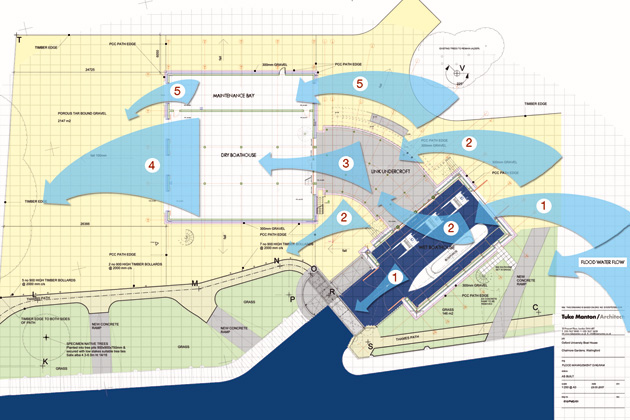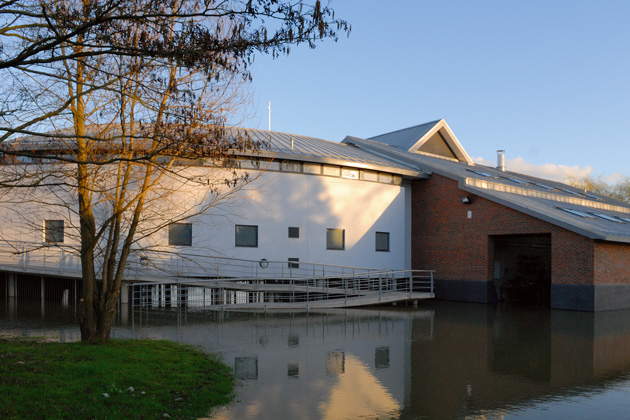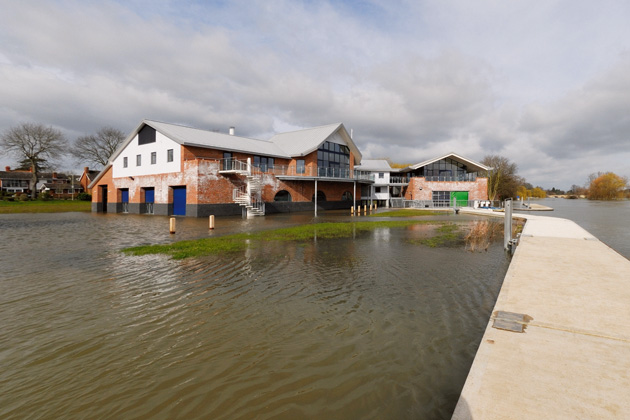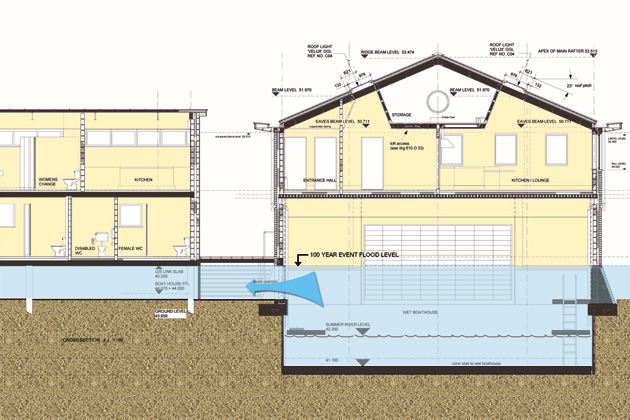The flood management system in place at the OUBC Fleming Boathouse Wallingford is the result of detailed discussions with the Environment Agency, who have approved the methodology and protocols. The site is a functional flood plain, and it was a requirement that it should continue to hold the same volume of flood water for each 250mm level of flooding as it previously did, to avoid the development of the building affecting protected sites elsewhere.
The Environment Agency provided information on the likely pattern of flood-water movement across the site, which had also to be unaffected by the design. The building was thus required to be totally ‘transparent’ to flooding, and to have no effect on the volume of flood water stored on the site.
The boathouse is linked to the Environment Agency's automatic flood alert early warning system, and a written protocol in the form of a Flood Management Plan for various degrees of flood warning has been provided to the boathouse manager.
All of the accommodation, other than boat storage, is placed above the 1% probability flood level stipulated by the Agency. This protected level has been set at the 1-in-100 year flood level, plus a 20% allowance for global warming. All electrical socket outlets are located above this height, and shut-off valves are provided to sink wastes below this level that are linked to the pumped drainage system, to avoid flood water being pumped into the town drains.

- Water flow through open grille construction of wet boathouse gates
- Water flow through built-in grilles at edges of link undercroft (underneath raised ground floor slab)
- On flood alert, internal sliding shutters opened allowing water flow through built-in grilles
- On flood alert, solid doors lifted and resulting openings secured by hinged grilles, allowing water flow through
- Perforated panels in base of solid doors allow water flow through
The design allows flood water to enter and leave the two ground level components of the building (the ‘wet’ and ‘dry’ boathouses) through open grilles, and to flow unimpeded under the third raised component (the ‘link building’). Large openings through the flank walls of the wet and dry boathouses underneath the link at each end, and doors at both ends of the wet boathouse made of open grillage, allow water to flow through at any time.
The wet boathouse is an unheated space, and there is no need to modify its internal environment. The dry boathouse in contrast contains racing shells and oars, which must be protected against major changes in temperature to maximise their life-expectancy.
As a result the large doors through which the boats enter and leave the dry boathouse, and through which flood water will leave the building, are formed from solid insulated panels. The grilles at the flood water entry end of the dry boathouse are also protected on the inside by similar vertically-sliding insulated shutters, opened by the boathouse manager under the flood alert protocol.
At the same time, the overhead doors at the exit end are half-raised, and shutter-type grilles swung across to allow water through, then locked in position. The overhead doors are finally dropped down onto the top of these shutters and locked in place to maintain complete security. At the end of the flood alert the process is reversed, and the wet and dry boathouses hosed down to clean away any tidal dirt or debris. The finishes up to the protected level are formed from waterproof concrete to simplify the cleaning-down operation.
Other measures exist to deal with the seasonal rise and fall of the river, a difference of approximately one metre outside of flood conditions. The wet boathouse contains floating pontoons that act as docks to which the coaching launches moor, with vertical ladders providing access from ground level that suit the full range of conditions. These pontoons float up and down with the changing river level, and are restrained by clamps sliding on vertical steels set into the base of the boathouse.
The underside of the swing bridge, carrying the Thames Path National Trail over the cut leading from the river into the wet boathouse, is set so that launches can pass underneath at normal summer river level without the need for the bridge to be opened. The winter river level of course requires the swing bridge to be opened to allow the launches in and out.



